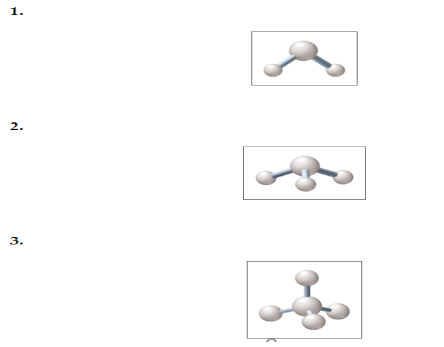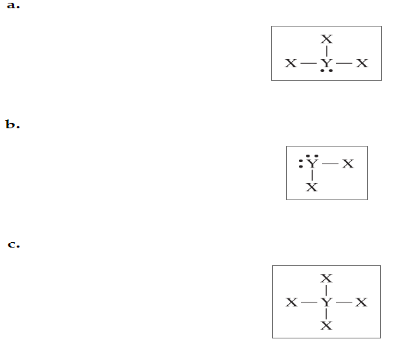
Modified Mastering Chemistry with Pearson eText -- Standalone Access Card -- for Chemistry: An Introduction to General, Organic, and Biological Chemistry (13th Edition)
13th Edition
ISBN: 9780134562254
Author: Karen C Timberlake
Publisher: PEARSON
expand_more
expand_more
format_list_bulleted
Concept explainers
Question
Chapter 6, Problem 6.103UTC
Interpretation Introduction
To determine:
The given Lewis structure (a to c) with correct diagram (1 to 3) of its shape and name of the shape indicating each molecule polar or nonpolar, assuming X and Y are non-metals.


Expert Solution & Answer
Want to see the full answer?
Check out a sample textbook solution
Students have asked these similar questions
None
None
4. Draw and label all possible isomers for [M(py)3(DMSO)2(CI)] (py = pyridine, DMSO
dimethylsulfoxide).
Chapter 6 Solutions
Modified Mastering Chemistry with Pearson eText -- Standalone Access Card -- for Chemistry: An Introduction to General, Organic, and Biological Chemistry (13th Edition)
Ch. 6.1 - State the number of electrons that be must be lost...Ch. 6.1 - State the number of electrons that must be gained...Ch. 6.1 - State the number of electrons lost or gained when...Ch. 6.1 - Prob. 6.4PPCh. 6.1 - Write the symbols for the ions with the following...Ch. 6.1 - Write the symbols for the ions with the following...Ch. 6.1 - Prob. 6.7PPCh. 6.1 - State the number of protons and electrons in each...Ch. 6.1 - Write the symbol for the ion of each of the...Ch. 6.1 - Write the symbol for the ion of each of the...
Ch. 6.1 - Write the names for each of the following ions:...Ch. 6.1 - Write the names for each of the following ions:...Ch. 6.1 - State the number of protons and electrons in each...Ch. 6.1 - State the number of protons and electrons in each...Ch. 6.2 - Which of the following pairs of elements are...Ch. 6.2 - Which of the following pairs of elements are...Ch. 6.2 - Write the correct ionic formula for the compound...Ch. 6.2 - Write the correct ionic formula for the compound...Ch. 6.2 - Write the symbols for the ions, and the correct...Ch. 6.2 - Write the symbols for the ions, and the correct...Ch. 6.3 - Write the name for each of the following ionic...Ch. 6.3 - Prob. 6.22PPCh. 6.3 - Write the name for each of the following ions...Ch. 6.3 - Prob. 6.24PPCh. 6.3 - Write the name for each of the following ionic...Ch. 6.3 - Prob. 6.26PPCh. 6.3 - Prob. 6.27PPCh. 6.3 - Prob. 6.28PPCh. 6.3 - Prob. 6.29PPCh. 6.3 - Write the formula for each of the following ionic...Ch. 6.3 - Prob. 6.31PPCh. 6.3 - Prob. 6.32PPCh. 6.3 - The following compounds contain ions that are...Ch. 6.3 - Prob. 6.34PPCh. 6.4 - Write the formula including the charge for each of...Ch. 6.4 - Prob. 6.36PPCh. 6.4 - Prob. 6.37PPCh. 6.4 - Prob. 6.38PPCh. 6.4 - Prob. 6.39PPCh. 6.4 - Prob. 6.40PPCh. 6.4 - Write the correct formula for the following ionic...Ch. 6.4 - Write the correct formula for the following ionic...Ch. 6.4 - Prob. 6.43PPCh. 6.4 - Write the formula for the polyatomic ion and name...Ch. 6.4 - Name each of the following ionic compounds:...Ch. 6.4 - Name each of the following ionic compounds:...Ch. 6.5 - Name each of the following molecular compounds:...Ch. 6.5 - Prob. 6.48PPCh. 6.5 - Prob. 6.49PPCh. 6.5 - Name each of the following molecular compounds: a....Ch. 6.5 - Write the formula for each of the following...Ch. 6.5 - Write the formula for each of the following...Ch. 6.5 - Write the formula for each of the following...Ch. 6.5 - Write the formula for each of the following...Ch. 6.5 - Name each of the following ionic or molecular...Ch. 6.5 - Name each of the following ionic or molecular...Ch. 6.6 - Determine the total number of valence electrons...Ch. 6.6 - Determine the total number of valence electrons...Ch. 6.6 - Draw the Lewis structure for each of the following...Ch. 6.6 - Draw the Lewis structure for each of the following...Ch. 6.7 - Describe the trend in electronegativity as...Ch. 6.7 - Prob. 6.62PPCh. 6.7 - Using the periodic table, arrange the atoms in...Ch. 6.7 - Using the periodic table, arrange the atoms in...Ch. 6.7 - Prob. 6.65PPCh. 6.7 - Prob. 6.66PPCh. 6.7 - Predict whether each of the following bonds is...Ch. 6.7 - Predict whether each of the following bonds is...Ch. 6.7 - For each of the following bonds, indicate the...Ch. 6.7 - For each of the following bonds, indicate the...Ch. 6.8 - Choose the shape (1 to 6) that matches each of the...Ch. 6.8 - Prob. 6.72PPCh. 6.8 - Prob. 6.73PPCh. 6.8 - Complete each of the following statements for a...Ch. 6.8 - Prob. 6.75PPCh. 6.8 - Prob. 6.76PPCh. 6.8 - 6.77 Use VSEPR theory to predict the shape of each...Ch. 6.8 - Use VSEPR theory to predict the shape of each of...Ch. 6.9 - Prob. 6.79PPCh. 6.9 - Prob. 6.80PPCh. 6.9 - Prob. 6.81PPCh. 6.9 - Identify each of the following molecules as polar...Ch. 6.9 - Prob. 6.83PPCh. 6.9 - Prob. 6.84PPCh. 6.9 - Prob. 6.85PPCh. 6.9 - Prob. 6.86PPCh. 6.9 - Prob. 6.87PPCh. 6.9 - Prob. 6.88PPCh. 6.9 - Prob. 6.89PPCh. 6.9 - Prob. 6.90PPCh. 6.9 - Prob. 6.91PPCh. 6.9 - Prob. 6.92PPCh. 6 - Prob. 6.93UTCCh. 6 - a. How does the octet rule explain the formation...Ch. 6 - Prob. 6.95UTCCh. 6 - Prob. 6.96UTCCh. 6 - Prob. 6.97UTCCh. 6 - Prob. 6.98UTCCh. 6 - Prob. 6.99UTCCh. 6 - Prob. 6.100UTCCh. 6 - Prob. 6.101UTCCh. 6 - 6.102 State the number of valence electrons,...Ch. 6 - Prob. 6.103UTCCh. 6 - Prob. 6.104UTCCh. 6 - Prob. 6.105UTCCh. 6 - Prob. 6.106UTCCh. 6 - Prob. 6.107UTCCh. 6 - Prob. 6.108UTCCh. 6 - Prob. 6.109APPCh. 6 - Prob. 6.110APPCh. 6 - Prob. 6.111APPCh. 6 - Prob. 6.112APPCh. 6 - Prob. 6.113APPCh. 6 - Prob. 6.114APPCh. 6 - Prob. 6.115APPCh. 6 - Prob. 6.116APPCh. 6 - Prob. 6.117APPCh. 6 - Prob. 6.118APPCh. 6 - Prob. 6.119APPCh. 6 - 6.120 Write the formula for each of the following...Ch. 6 - Prob. 6.121APPCh. 6 - Prob. 6.122APPCh. 6 - Prob. 6.123APPCh. 6 - Prob. 6.124APPCh. 6 - Prob. 6.125APPCh. 6 - Prob. 6.126APPCh. 6 - 6.127 Draw the Lewis structure for each of the...Ch. 6 - 6.128 Draw the Lewis structure for each of the...Ch. 6 - Prob. 6.129APPCh. 6 - 6.130 Use the periodic table to arrange the...Ch. 6 - Prob. 6.131APPCh. 6 - Prob. 6.132APPCh. 6 - Show the dipole arrow for each of the following...Ch. 6 - Show the dipole arrow for each of the following...Ch. 6 - Prob. 6.135APPCh. 6 - Prob. 6.136APPCh. 6 - Prob. 6.137APPCh. 6 - Prob. 6.138APPCh. 6 - Prob. 6.139APPCh. 6 - Prob. 6.140APPCh. 6 - Prob. 6.141APPCh. 6 - Prob. 6.142APPCh. 6 - Prob. 6.143APPCh. 6 - 6.144 Classify each of the following molecules as...Ch. 6 - Indicate the major type of intermolecular...Ch. 6 - Indicate the major type of intermolecular...Ch. 6 - Prob. 6.147CPCh. 6 - Prob. 6.148CPCh. 6 - Prob. 6.149CPCh. 6 - Prob. 6.150CPCh. 6 - Prob. 6.151CPCh. 6 - Prob. 6.152CPCh. 6 - Prob. 6.153CPCh. 6 - Prob. 6.154CPCh. 6 - Prob. 6.155CPCh. 6 - Prob. 6.156CPCh. 6 - Prob. 7CICh. 6 - Prob. 8CICh. 6 - Prob. 9CICh. 6 - Prob. 10CICh. 6 - Prob. 11CICh. 6 - Of much concern to environmentalists is radon-222,...
Knowledge Booster
Learn more about
Need a deep-dive on the concept behind this application? Look no further. Learn more about this topic, chemistry and related others by exploring similar questions and additional content below.Similar questions
- The emission data in cps displayed in Table 1 is reported to two decimal places by the chemist. However, the instrument output is shown in Table 2. Table 2. Iron emission from ICP-AES Sample Blank Standard Emission, cps 579.503252562 9308340.13122 Unknown Sample 343.232365741 Did the chemist make the correct choice in how they choose to display the data up in Table 1? Choose the best explanation from the choices below. No. Since the instrument calculates 12 digits for all values, they should all be kept and not truncated. Doing so would eliminate significant information. No. Since the instrument calculates 5 decimal places for the standard, all of the values should be limited to the same number. The other decimal places are not significant for the blank and unknown sample. Yes. The way Saman made the standards was limited by the 250-mL volumetric flask. This glassware can report values to 2 decimal places, and this establishes our number of significant figures. Yes. Instrumental data…arrow_forwardSteps and explanation pleasearrow_forwardSteps and explanation to undertand concepts.arrow_forward
- Nonearrow_forward7. Draw a curved arrow mechanism for the following reaction. HO cat. HCI OH in dioxane with 4A molecular sievesarrow_forwardTry: Convert the given 3D perspective structure to Newman projection about C2 - C3 bond (C2 carbon in the front). Also, show Newman projection of other possible staggered conformers and circle the most stable conformation. Use the template shown. F H3C Br Harrow_forward
- Nonearrow_forward16. Consider the probability distribution p(x) = ax", 0 ≤ x ≤ 1 for a positive integer n. A. Derive an expression for the constant a, to normalize p(x). B. Compute the average (x) as a function of n. C. Compute σ2 = (x²) - (x)², the variance of x, as a function of n.arrow_forward451. Use the diffusion model from lecture that showed the likelihood of mixing occurring in a lattice model with eight lattice sites: Case Left Right A B C Permeable Barrier → and show that with 2V lattice sites on each side of the permeable barrier and a total of 2V white particles and 2V black particles, that perfect de-mixing (all one color on each side of the barrier) becomes increasingly unlikely as V increases.arrow_forward
- 46. Consider an ideal gas that occupies 2.50 dm³ at a pressure of 3.00 bar. If the gas is compressed isothermally at a constant external pressure so that the final volume is 0.500 dm³, calculate the smallest value Rest can have. Calculate the work involved using this value of Rext.arrow_forwardNonearrow_forward2010. Suppose that a 10 kg mass of iron at 20 C is dropped from a heigh of 100 meters. What is the kinetics energy of the mass just before it hits the ground, assuming no air resistance? What is its speed? What would be the final temperature of the mass if all the kinetic energy at impact is transformed into internal energy? The molar heat capacity of iron is Cpp = 25.1J mol-¹ K-1 and the gravitational acceleration constant is 9.8 m s¯² |arrow_forward
arrow_back_ios
SEE MORE QUESTIONS
arrow_forward_ios
Recommended textbooks for you
 ChemistryChemistryISBN:9781305957404Author:Steven S. Zumdahl, Susan A. Zumdahl, Donald J. DeCostePublisher:Cengage Learning
ChemistryChemistryISBN:9781305957404Author:Steven S. Zumdahl, Susan A. Zumdahl, Donald J. DeCostePublisher:Cengage Learning ChemistryChemistryISBN:9781259911156Author:Raymond Chang Dr., Jason Overby ProfessorPublisher:McGraw-Hill Education
ChemistryChemistryISBN:9781259911156Author:Raymond Chang Dr., Jason Overby ProfessorPublisher:McGraw-Hill Education Principles of Instrumental AnalysisChemistryISBN:9781305577213Author:Douglas A. Skoog, F. James Holler, Stanley R. CrouchPublisher:Cengage Learning
Principles of Instrumental AnalysisChemistryISBN:9781305577213Author:Douglas A. Skoog, F. James Holler, Stanley R. CrouchPublisher:Cengage Learning Organic ChemistryChemistryISBN:9780078021558Author:Janice Gorzynski Smith Dr.Publisher:McGraw-Hill Education
Organic ChemistryChemistryISBN:9780078021558Author:Janice Gorzynski Smith Dr.Publisher:McGraw-Hill Education Chemistry: Principles and ReactionsChemistryISBN:9781305079373Author:William L. Masterton, Cecile N. HurleyPublisher:Cengage Learning
Chemistry: Principles and ReactionsChemistryISBN:9781305079373Author:William L. Masterton, Cecile N. HurleyPublisher:Cengage Learning Elementary Principles of Chemical Processes, Bind...ChemistryISBN:9781118431221Author:Richard M. Felder, Ronald W. Rousseau, Lisa G. BullardPublisher:WILEY
Elementary Principles of Chemical Processes, Bind...ChemistryISBN:9781118431221Author:Richard M. Felder, Ronald W. Rousseau, Lisa G. BullardPublisher:WILEY

Chemistry
Chemistry
ISBN:9781305957404
Author:Steven S. Zumdahl, Susan A. Zumdahl, Donald J. DeCoste
Publisher:Cengage Learning

Chemistry
Chemistry
ISBN:9781259911156
Author:Raymond Chang Dr., Jason Overby Professor
Publisher:McGraw-Hill Education

Principles of Instrumental Analysis
Chemistry
ISBN:9781305577213
Author:Douglas A. Skoog, F. James Holler, Stanley R. Crouch
Publisher:Cengage Learning

Organic Chemistry
Chemistry
ISBN:9780078021558
Author:Janice Gorzynski Smith Dr.
Publisher:McGraw-Hill Education

Chemistry: Principles and Reactions
Chemistry
ISBN:9781305079373
Author:William L. Masterton, Cecile N. Hurley
Publisher:Cengage Learning

Elementary Principles of Chemical Processes, Bind...
Chemistry
ISBN:9781118431221
Author:Richard M. Felder, Ronald W. Rousseau, Lisa G. Bullard
Publisher:WILEY